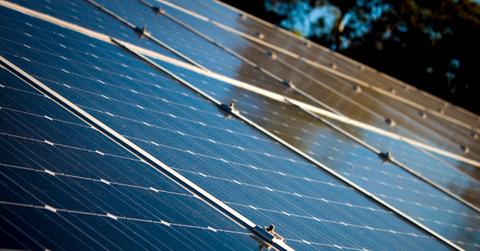'Power On Puerto Rico' Is Sending Solar Trailers To The Island for Free
Several organizations are banding together to send trailers equipped with solar panels to powerless Puerto Rico so residents can charge their cell phones, lap tops and more.
Updated Nov. 19 2020, 9:38 p.m. ET
It's been over two months since Hurricane Maria swept through Puerto Rico, casting darkness and disarray over the island territory. The hurricane knocked out power, cell service and running water, and little infrastructure has been repaired in the time since. Much of what has been restored, however, has been the handiwork of renewable energy companies seeking to test innovative new off-grid systems for power.
The latest is an initiative called "Power On Puerto Rico," a collaborative effort between the Amicus Solar Cooperative, a nationwide solar energy cooperative, and Amurtel, an international disaster relief organization. Together, the organizations are sending 100 Solar Outreach Systems (SOS) to the island. Each SOS consists of a 12-foot-long trailer equipped with six foldable solar panels strong enough to charge cell phones, lights, laptops, radios, and more, providing an off-grid, mobile system for Puerto Rico's citizens to gain some access to power.
Solar company ReVision Energy is building the emergency power hubs in North Andover, Massachusetts, and is lending them to Puerto Rico for an indefinite amount of time. In other words, it won't cost the territory a thing. But that's not to say this is a longterm solution, or an immediate one—it could take three to six months to build all 100 units.
"This is going to be supplemental emergency power for basic lighting, small electronics, communications," ReVision Co-Founder Phil Coupe told the Portland Press Herald. But "based on the level of damage that we are getting reports on, these things will be useful for a year or more."
Puerto Rico's government says that the majority of the power to the island should be restored by Christmas, but Coupe believes these trailers will still be useful for places in need of emergency or supplemental power.
"We are preparing for a climate where bad weather events are getting worse all the time," he said. "In that environment, a utility grid infrastructure with poles and wires is extremely vulnerable. Systems with power regeneration and batteries are proving to be resilient to those events."
Other companies and organizations have observed the same vulnerability and are rushing to test out their off-grid solutions on the island. Quickly after the hurricane, Tesla sent hundreds of batteries to the island, which could be paired with solar panels to restore electric power there. A few days later, the company re-powered the Children's Hospital, and began talks with Puerto Rican Governor Ricardo Rossello to make the island "a flagship project" for Tesla's scalable solar systems.
Another company sent solar-powered balloons to the island to give residents cell service; The Solar Energy Industries Association sent $300,000 worth of solar equipment to the island; and solar company Sunrun sent rooftop solar panels.
For their part, Puerto Rico is receptive to these ideas: the government is lobbying to use federal emergency funds to create a newer, better grid rather than settle for repairing the old one. Manuel Laboy, Department of Economic Development and Commerce secretary, said officials are looking into different options including microgrids and regional grids that use solar and energy storage as well as other renewable sources, according to Bloomberg.
But before the island sets up permanent off-grid infrastructure, the number one focus is getting power to citizens as fast as possible. And Power On Puerto Rico is on the job.
